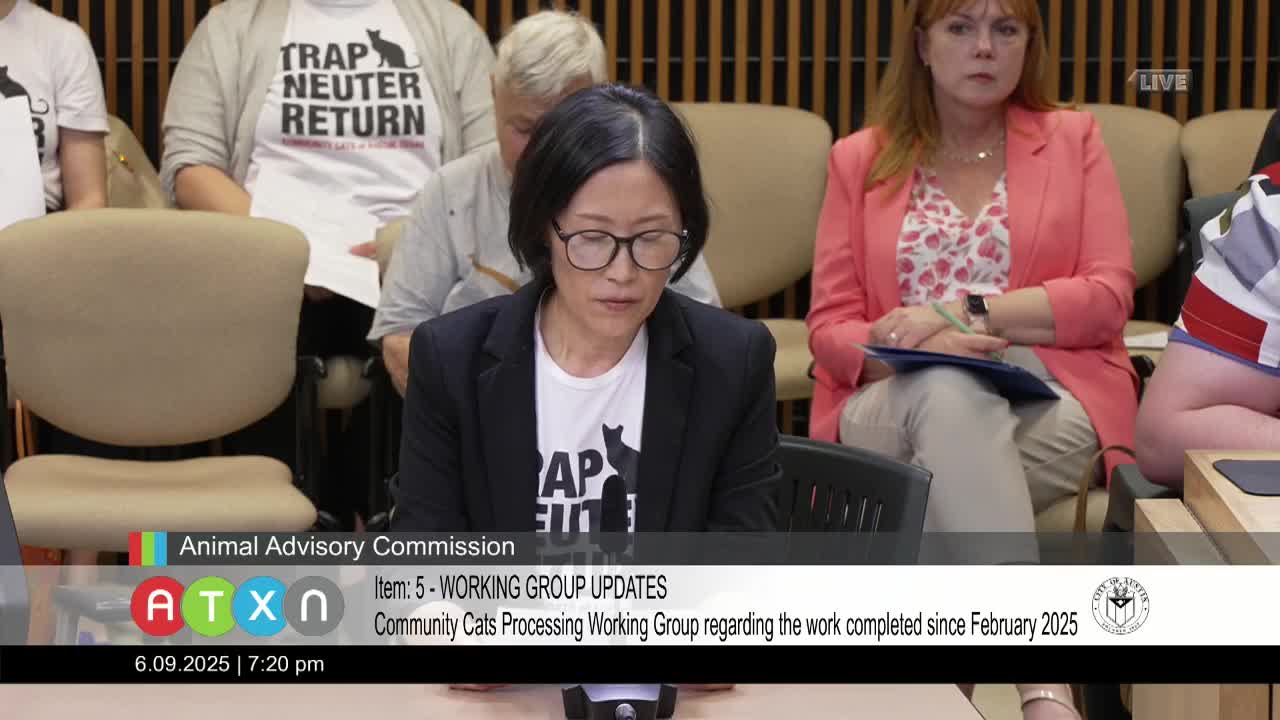Community Cats Working Group urges city to enhance volunteer support and resources
June 09, 2025 | Austin, Travis County, Texas
This article was created by AI summarizing key points discussed. AI makes mistakes, so for full details and context, please refer to the video of the full meeting. Please report any errors so we can fix them. Report an error »

During the recent meeting of the Austin Animal Advisory Commission on June 9, 2025, significant discussions centered around the challenges faced by volunteers involved in the Community Cats Program (CCP). The meeting highlighted the urgent need for improved communication, support, and resources for those dedicated to managing community cat populations in Travis County.
One of the primary concerns raised was the lack of a unified protocol for handling community cats, which has led to confusion and misinformation. Volunteers expressed frustration over the inconsistent guidance provided to them and the public, particularly from the 3-1-1 service, which relies on outdated information. This communication breakdown has eroded public trust in the program, emphasizing the need for a standardized approach that all public-facing teams can follow.
Financial sustainability was another critical topic. Volunteers pointed out that the current $250 cap on medical vouchers for community cats has not been adjusted in over a decade, despite rising veterinary costs. Many cats require extensive medical care, often exceeding the voucher amount, which places a financial burden on volunteers and Good Samaritans. A call for a fiscal review of the voucher system was made, highlighting the necessity for a reassessment to ensure that volunteers can continue to provide essential care for community cats.
The emotional toll on volunteers was also a focal point of the discussion. Many volunteers juggle their responsibilities with full-time jobs, leading to burnout and a high turnover rate. The need for better support systems was emphasized, with suggestions for a designated staff role to assist with trapping and community outreach. This would not only alleviate the burden on volunteers but also enhance the program's responsiveness to urgent situations involving sick or pregnant cats.
Additionally, the meeting addressed the importance of visibility and safety for volunteers in the field. A recommendation was made to refine identification materials to ensure that volunteers are easily recognized as part of the city's program. However, frustrations arose when new materials were developed without consulting the volunteers who would use them, leading to a disconnect between the program's administration and its frontline workers.
In conclusion, the discussions at the Austin Animal Advisory Commission meeting underscored the pressing need for improved communication, financial support, and volunteer resources within the Community Cats Program. As the commission considers these recommendations, the hope is to foster a more collaborative environment that empowers volunteers and enhances the overall effectiveness of the program in managing community cat populations.
One of the primary concerns raised was the lack of a unified protocol for handling community cats, which has led to confusion and misinformation. Volunteers expressed frustration over the inconsistent guidance provided to them and the public, particularly from the 3-1-1 service, which relies on outdated information. This communication breakdown has eroded public trust in the program, emphasizing the need for a standardized approach that all public-facing teams can follow.
Financial sustainability was another critical topic. Volunteers pointed out that the current $250 cap on medical vouchers for community cats has not been adjusted in over a decade, despite rising veterinary costs. Many cats require extensive medical care, often exceeding the voucher amount, which places a financial burden on volunteers and Good Samaritans. A call for a fiscal review of the voucher system was made, highlighting the necessity for a reassessment to ensure that volunteers can continue to provide essential care for community cats.
The emotional toll on volunteers was also a focal point of the discussion. Many volunteers juggle their responsibilities with full-time jobs, leading to burnout and a high turnover rate. The need for better support systems was emphasized, with suggestions for a designated staff role to assist with trapping and community outreach. This would not only alleviate the burden on volunteers but also enhance the program's responsiveness to urgent situations involving sick or pregnant cats.
Additionally, the meeting addressed the importance of visibility and safety for volunteers in the field. A recommendation was made to refine identification materials to ensure that volunteers are easily recognized as part of the city's program. However, frustrations arose when new materials were developed without consulting the volunteers who would use them, leading to a disconnect between the program's administration and its frontline workers.
In conclusion, the discussions at the Austin Animal Advisory Commission meeting underscored the pressing need for improved communication, financial support, and volunteer resources within the Community Cats Program. As the commission considers these recommendations, the hope is to foster a more collaborative environment that empowers volunteers and enhances the overall effectiveness of the program in managing community cat populations.
View full meeting
This article is based on a recent meeting—watch the full video and explore the complete transcript for deeper insights into the discussion.
View full meeting
